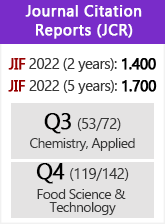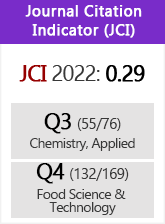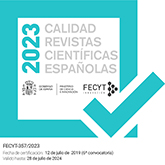Nutritional and functional characteristics of Erophaca baetica seeds, a legume endemic to the Mediterranean region
DOI:
https://doi.org/10.3989/gya.107412Keywords:
Amino acids, Erophaca baetica, Fatty acids, Polyphenols, ProteinAbstract
Erophaca baetica is a legume endemic to the Mediterranean region. Although the fruits and seeds are large, the presence of the “locoism” which produces the alkaloid, swainsonine has prevented its use as animal feed or for human nutrition. Their protein content and chromatographic profile, amino acid composition, fatty acid composition, and polyphenol contents have been determined in order to explore the potential of the E. baetica seeds as a source of dietary protein with functional components. The protein content was found to be 36% (w/w), and an amino acid analysis revealed a deficiency in sulphur amino acids, tryptophane, and lysine. The low lysine content is probably due to the abundance of alkaloids metabolically derived from this amino acid. Oleic and linoleic acids are the major fatty acids in the seeds. The antioxidant activity of polyphenol extracts was higher than the activity of the polyphenols extracted from most edible legume seeds. Hence, E. baetica seeds represent a promising source of functional and nutritional components on the condition that the anti-nutritional alkaloids are previously removed.
Downloads
References
Alaiz M, Navarro JL, Giron J, Vioque E. 1992. Amino acid analysis by high-performance liquid chromatography after derivatization with diethylethoxymethylenemalonate. J. Cromatogr. 591, 181-186. http://dx.doi.org/10.1016/0021-9673(92)80236-N
Al-Saikhan MS, Howard LR, Miller JC jr. 1995. Antioxidant activity and total phenolics in different genotypes of potato (Solanum tuberosum, L.). J. Food Sci. 60, 341-343. http://dx.doi.org/10.1111/j.1365-2621.1995.tb05668.x
Alsmeyer RH, Cunningham AE, Happich ML. 1974. Equations predict PER from amino acid analysis. Food Technol. 28, 34-38.
Aniszewski T. 2007. Alkaloids - Secrets of Life. Alkaloid Chemistry, Biological Significance, Applications and Ecological Role. Ed. Elsevier, pp. 87-89.
AOAC. Official Methods of Analysis (15th edn). Association of Official Analytical Chemists.Washington. DC. Pp. 2-32. 1997.
Dubois M, Gilles K, Hamilton J, Reber P, Smith F. 1956. Colorimetric method for determination sugars and related substances. Anal. Chem. 28, 350-356. http://dx.doi.org/10.1021/ac60111a017
FAO/WHO/UNU. 1985. Energy and protein requirements. Report of the joint FAO/WHO/UNU expert consultation. Technical report series No. 724. FAO. WHO and the United Nations University. Geneva. Switzerland.
Friedman M. 1996. Nutritional value of proteins from different food sources. A review. J. Agric. Food Chem. 44, 6-29. http://dx.doi.org/10.1021/jf9400167
Garcés R, Mancha M. 1993. One-step lipid extraction and fatty acid methyl esters preparation from fresh plant tissues. Anal. Biochem. 211, 139-143. http://dx.doi.org/10.1006/abio.1993.1244 PMid:8323025
Ghuman PK, Mann SK, Hira CK. 1990. Evaluation of protein quality of peanut (Arachis hypogaea) cultivars using Tetrahymena pyriformis. J. Agric. Food Chem. 52, 137-139. http://dx.doi.org/10.1002/jsfa.2740520115
Hidalgo FJ, Alaiz M, Zamora R. 2001. Determination of peptides and proteins in fats and oils. Anal. Chem. 73, 698-702. http://dx.doi.org/10.1021/ac000876o PMid:11217787
James LF, Panter KE, Gaffield W, Molyneux RJ. 2004. Biomedical applications of poisonous plant research. J. Agric. Food Chem. 52, 3211-3230. http://dx.doi.org/10.1021/jf0308206 PMid:15161174
Lqari H, Vioque J, Pedroche J, Millán F. 2002. Lupinus angustifolius protein isolates: chemical composition. Functional properties and protein characterization. Food Chem. 76, 349-356. http://dx.doi.org/10.1016/S0308-8146(01)00285-0
Mallet JF, Cerrati C, Ucciani E, Gamisana J, Gruber M. 1994. Antioxidant activity of plant leaves in relation to their a-tocopherol content. Food Chem. 49, 61-65. http://dx.doi.org/10.1016/0308-8146(94)90233-X
Marco GJ. 1968. A rapid method for evaluation of antioxidants. J. Am. Oil Chem. Soc. 45, 594-598. http://dx.doi.org/10.1007/BF02668958
Moughan PJ. 2005. Dietary protein quality in humans - an overview. J. AOAC Internat. 88, 874-876. PMid:16001865
Morup IK, Olesen ES. 1976. New method for prediction of protein value from essential amino acid pattern. Nutr. Rep. Internat. 13, 355-365.
Oomah BD, Mazza G. 1996. Flavonoids and antioxidative activities in buckwheat. J. Agric. Food Chem. 44, 1746-1750. http://dx.doi.org/10.1021/jf9508357
Pastor-Cavada E, Juan R, Pastor JE, Alaiz M, Vioque J. 2009a. Analytical nutritional characteristics of seed proteins in six wild Lupinus species from Southern Spain. Food Chem. 117, 466-469. http://dx.doi.org/10.1016/j.foodchem.2009.04.039
Pastor-Cavada E, Juan R, Pastor JE, Alaiz M, Vioque J. 2009b. Chemical Composition and Nutritional Characteristics of the Seed Oil of Wild Lathyrus, Lens and Pisum Species from Southern Spain. J. Am. Oil Chem. Soc. 86, 329-335. http://dx.doi.org/10.1007/s11746-009-1352-0
Pastor-Cavada E, Juan R, Pastor JE, Alaiz M, Vioque J. 2009c. Fatty acid distribution in the seed flour of wild Vicia species from Southern Spain. J. Am. Oil Chem. Soc. 86, 977-983. http://dx.doi.org/10.1007/s11746-009-1426-z
Pastor-Cavada E, Juan R, Pastor JE, Alaiz M, Vioque J. 2009d. Antioxidant activivty of seed polyphenols in fifteen wild Lathyrus species from South Spain. LWTFood Sci. Technol. 42, 705-709.
Pastor-Cavada E, Juan R, Pastor JE, Alaiz M, Girón-Calle J, Vioque J. 2011. Antioxidative activivty in the seeds of 28 Vicia species from southern Spain. J. Food Biochem. 35, 1373-1380. http://dx.doi.org/10.1111/j.1745-4514.2010.00459.x
Pastor-Cavada E, Juan R, Pastor JE, Alaiz M, Vioque J. 2011a. Nutritional characteristics of seed proteins in 15 Lathyrus species (fabaceae) from Southern Spain. LWT-Food Sci. Technol. 44, 1059-1964.
Pastor-Cavada E, Juan R, Pastor JE, Alaiz M, Vioque J. 2011b. Nutritional Characteristics of Seed Proteins in 28 Vicia Species (Fabaceae) from Southern Spain. J. Food Sci. 76, 1118-1124. http://dx.doi.org/10.1111/j.1750-3841.2011.02336.x PMid:21913919
Podlech D. 1993. Beiträge zur Kenntnis der Gattung Astragalus L. (Leguminosae). Sendtera 1, 267-272.
Ramos S. 2007. Effects of dietary flavonoids on apoptotic related to cancer chemoprevention. J. Nutr. Biochem. 18, 427-442. http://dx.doi.org/10.1016/j.jnutbio.2006.11.004 PMid:17321735
Rios JL, Waterman PG. 1997. A review of the pharmacology and toxicology of Astragalus. Phytother. Res. 11, 411-418. http://dx.doi.org/10.1002/(SICI)1099-1573(199709)11:6<411::AID-PTR132>3.0.CO;2-6
Schägger H, von Jagow G. 1987. Tricine-sodium dodecyl sulfatepolyacrylamide gel electrophoresis for the separation of proteins in the range from 1 to 100 kDa. Anal. Biochem. 166, 368-379. http://dx.doi.org/10.1016/0003-2697(87)90587-2
Singleton VL, Orthofer R, Lamuela-Raventos RM. 1999. Análisis of total phenols and other oxidation substrates and antioxidants by means of Folin-Ciocalteu reagent. Methods Enzymol. 299, 152-178. http://dx.doi.org/10.1016/S0076-6879(99)99017-1
Sun JY, Yang H, Miao S, Li JP, Wang SW, Zhu MZ, Xie YH, Wang JB, Liu Z, Yang Q. 2009. Suppressive effects of swainsonine on C6 glioma cell in vitro and in vivo. Phytomed. 16, 1070-1074. http://dx.doi.org/10.1016/j.phymed.2009.02.012 PMid:19427771
Sun JY, Zhu MZ, Wang SW, Miao S, Xie YH, Wang JB. 2007. Inhibition of the growth of human gastric carcinoma in vivo and in vitro by swainsonine. Phytomed. 14, 353-359. http://dx.doi.org/10.1016/j.phymed.2006.08.003 PMid:17097281
Velioglu YS, Mazza G, Gao L, Oomah BD. 1997. Antioxidant activity and total phenolics in selected fruits, vegetables and grain products. J. Agric. Food Chem. 45, 304-309.
Yan QJ, Jiang ZQ, Yang S, Deng W, Han L. 2005. A novel homodimeric lectin from Astragalus mongholicus with antifungal activity. Arch. Biochem. Biophys. 442, 72-81. http://dx.doi.org/10.1016/j.abb.2005.07.019 PMid:16140255
Yust MM, Pedroche J, Girón-Calle J, Vioque J, Millán F, Alaiz M. 2004. Determination of tryptophan by high-performance liquid chromatography of alkaline hydrolysates with spectrophotometric detection. Food Chem. 85, 317-320. http://dx.doi.org/10.1016/j.foodchem.2003.07.026
Downloads
Published
How to Cite
Issue
Section
License
Copyright (c) 2013 Consejo Superior de Investigaciones Científicas (CSIC)

This work is licensed under a Creative Commons Attribution 4.0 International License.
© CSIC. Manuscripts published in both the printed and online versions of this Journal are the property of Consejo Superior de Investigaciones Científicas, and quoting this source is a requirement for any partial or full reproduction.All contents of this electronic edition, except where otherwise noted, are distributed under a “Creative Commons Attribution 4.0 International” (CC BY 4.0) License. You may read here the basic information and the legal text of the license. The indication of the CC BY 4.0 License must be expressly stated in this way when necessary.
Self-archiving in repositories, personal webpages or similar, of any version other than the published by the Editor, is not allowed.
















